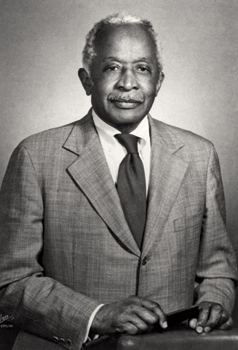Then & Now: Black History Highlights of Delaware explores the impact of Redding and Stevenson
Then & Now: Black History Highlights of Delaware is a collaboration between Carlton Hall, a Historian-Architectural Historian with the Delaware Division of Historical and Cultural Affairs State Historic Preservation Office, and Desiree May, the Division’s Social Media Lead, to highlight Black-owned businesses, figures and trades of our history while shining a light on Black-owned businesses, figures, and trades of today. We know the importance of learning from our past and how our history impacts our now and the future, so let’s dive in!

THEN:
Louis L. Redding was born in Virginia but moved to Wilmington, Delaware, as a child. He graduated in 1919 from the segregated Howard High School in Wilmington, which was the only high school in the state for African Americans. He graduated from Brown University in 1923. Redding graduated from Harvard Law School in 1928 and was the only African American in his graduating class. Redding was admitted to the Delaware Bar in 1929 and was the only Black lawyer of Delaware for the next 25 years. He practiced law for 57 years. He worked with a group of lawyers that included Thurgood Marshall in the Brown v. Board of Education case of 1954. Brown v. Board of Education was a landmark decision by the U.S. Supreme Court, which ruled that U.S. state laws establishing racial segregation in public schools are unconstitutional.
NOW:

Bryan Stevenson was born in Milton, Delaware, during segregation with his family living in a segregated neighborhood of Milton. Although the Civil Rights Act was passed in 1964, segregation wasn’t enforced in Milton as soon as the law was passed. The Stevenson family attended Prospect AME Church in Georgetown where he sang in the choir and played piano. Stevenson attended and graduated from Cape Henlopen High School in 1978. He graduated from Eastern University in 1981. In 1985 he graduated from Harvard Law School. He founded the Equal Justice Initiative in 1989, which provides legal representation to those who may have been denied a fair trial. Stevenson started the National Memorial for Peace and Justice and The Legacy Museum: From Enslavement to Mass Incarceration in Montgomery, Alabama, as tribute to over 3,000 African Americans lynched in the deep south during Jim Crow.
Stevenson has initiated major new anti-poverty and anti-discrimination efforts that challenge inequality in America. In November 2018, the same year the National Memorial and Legacy Museum opened, Stevenson received the Benjamin Franklin Medal from the American Philosophical Society as a “Drum major for justice and mercy.” In 2020, he shared the Right Livelihood Award with international activists Nasrin Sotoudeh, Ales Bialiatski and Lottie Cunningham Wren.

He is also known for his 2014 New York Times bestselling book, “Just Mercy: A Story of Justice and Redemption,” and the 2019 film adaptation. The book is Stevenson’s memoir, documenting his career defending disadvantaged clients. The story focuses on injustices in the United States judicial system, specifically highlighting Stevenson’s efforts to overturn the wrongful conviction of Walter McMillian, as well as his work on other cases defending poor or marginalized clients, even children.
The 2019 film adaptation, “Just Mercy,” was co-written and directed by Destin Daniel Cretton and stars Michael B. Jordan as Bryan Stevenson and Jamie Foxx as Walter McMillian.
In late 2022, a historic plaque honoring Stevenson was unveiled outside of the Lydia Cannon Museum in his hometown of Milton. Read more about the marker and its significance in this Cape Gazette article.


